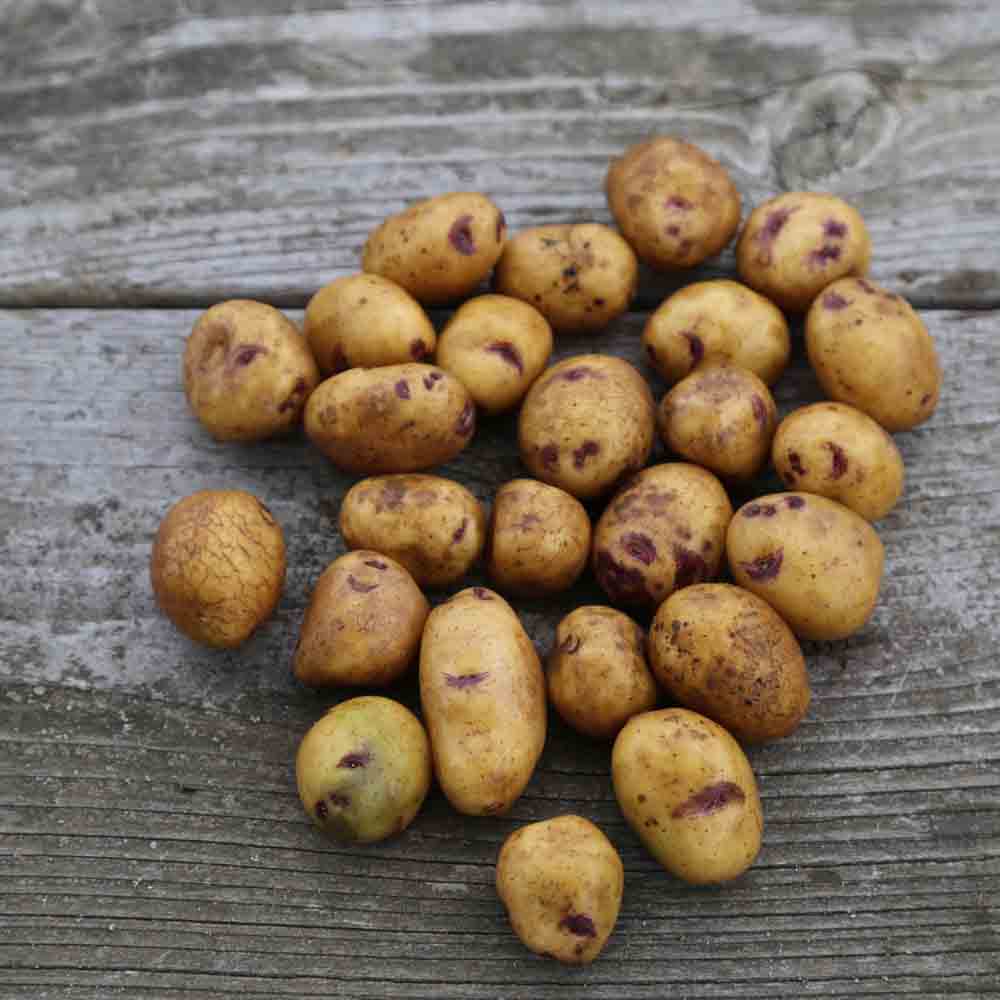BLUE BELLE NT POTATO
Solanum tuberosum
The Blue Belle potato is a medium-late variety (28/35) recognizable by its yellow flesh and the purple moons on each eye shaped like a smile. Ideal for mashed potatoes, soups, and broths, baked or as fries, the potato has a slightly sweet taste without being overpowering. It is a versatile potato. Good yield. Its purple markings are retained when cooked.
Storing potatoes before planting:
Open the potato net and spread them out on newspaper. Place everything in a dark place where the temperature is around 4-5°C. They will have time to germinate slowly and you can then store them for about 2 months.
Prepare the soil before planting
You can incorporate manure or organic fertilizer before planting your potatoes. Do not plant potatoes in the same spot two years in a row.
Sprouting potatoes
To sprout your potatoes, lay them flat in a well-ventilated area at 10-15°C with light but not direct sunlight (a back kitchen, for example). They should sprout in 4 to 6 weeks. As soon as sprouts appear, plant them in warmed soil and protect the plants if frost is still a risk.
Culture Council
Plant in April/May at a depth of 15 cm, spaced 40/50 cm apart in the row, in rows 60/70 cm apart. Exposure: sunny. Soil: deep, fertile and well-loosened.
Potatoes are very sensitive to drought, so watering should be generous during tuber formation and growth. Once the foliage has faded, watering is no longer necessary, as the tubers may not keep as well.
Earthing up is essential as the stems emerge, to support the plants, encourage tuber development, and prevent them from turning green. Start earthing up the plants as soon as they reach 25 cm. This involves burying the bottom of the stems, bringing the soil back towards the plant using a hoe. Repeat this process during the first month of the plant's development. Hoe occasionally between the plants to aerate the soil and eliminate weeds.
Potato harvest
Harvest after approximately 120 days of cultivation from July to September. Wait until the leaves have wilted and harvest the tubers with a garden fork.
Storing potatoes
Store in a cool, dry place away from light.
The Blue Belle potato is a medium-late variety (28/35) recognizable by its yellow flesh and the purple moons on each eye shaped like a smile. Ideal for mashed potatoes, soups, and broths, baked or as fries, the potato has a slightly sweet taste without being overpowering. It is a versatile potato. Good yield. Its purple markings are retained when cooked.
Storing potatoes before planting
Unsprouted tubers should be stored on a shelf in a dry, well-ventilated area. They should be left to germinate for 4 to 5 weeks between 5 and 7°C. Be careful not to allow excessive temperature variations. Plants should not be kept in the dark; on the contrary, it is best to germinate them in a well-lit area to obtain short, stocky sprouts.
If storage is to be longer, it is advisable to place them in a dry place at a low temperature (2 to 4°C, frost-free) to maintain the dormant state.
Prepare the soil before planting
You can incorporate manure or organic fertilizer before planting your potatoes.
Sprouting potatoes
Unsprouted tubers should be stored on a shelf in a dry, well-ventilated area. They should be left to germinate for 4 to 5 weeks between 5 and 7°C. Be careful not to allow excessive temperature variations. Plants should not be kept in the dark; on the contrary, it is best to germinate them in a well-lit area to obtain short, stocky sprouts.







